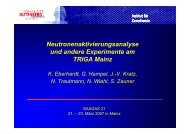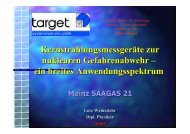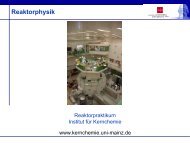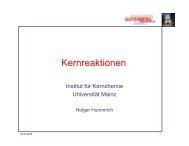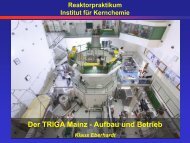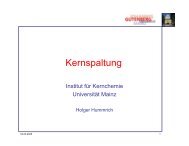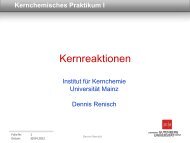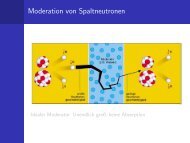jahresbericht 2007 - Institut für Kernchemie - Johannes Gutenberg ...
jahresbericht 2007 - Institut für Kernchemie - Johannes Gutenberg ...
jahresbericht 2007 - Institut für Kernchemie - Johannes Gutenberg ...
You also want an ePaper? Increase the reach of your titles
YUMPU automatically turns print PDFs into web optimized ePapers that Google loves.
Phosphonate complexes of Gallium-68 for bone tumor imaging<br />
M. Fellner 1 , P. Riß 1 , N. Loktionova 1 , K. Zhernosekov 1 , I. Lukeš 2 , C. F. Geraldes 3 , F. Rösch 1<br />
1<br />
Nuclear <strong>Institut</strong>e, <strong>Johannes</strong> <strong>Gutenberg</strong> University of Mainz, Fritz Strassmann Weg 2, 55128 Mainz, Germany<br />
2<br />
Department of Inorganic Chemistry, Charles University, Hlavova 2030, 12840 Prague, Czech Republic<br />
3<br />
Department of Biochemistry, FCT, University of Coimbra, 3049 Coimbra, Portugal<br />
Introduction: As 99m Tc-phosphonates are well established<br />
tracers for the diagnoses of bone metastases using SPECT,<br />
analogue attempts for PET using the Germanium-68/Gallium-<br />
68 generator based 68 Ga tracers would be potentially useful.<br />
Therefore molecules / ligands containing phosphonate structures<br />
with binding affinities to hydroxyapatite and being adequate<br />
complexing agents for trivalent Gallium could be considered<br />
as interesting targeting vectors for the synthesis of generator-based<br />
PET-tracers for skeletal imaging. The aim of the<br />
study was to synthesize complexes with different types of<br />
phosphonate ligands in order to understand the rational of<br />
68 Ga-phosphonates related to apatite binding.<br />
Experimental: Germanium-68 (T½ = 270.95 d) provides the<br />
positron emitter Gallium-68 (T½ = 67.7 min) as an easily<br />
available and relatively inexpensive source of a PET nuclide<br />
for labeling interesting targeting vectors. Germanium-68 is<br />
fixed on a solid phase of titanium dioxide. Through HCl Gallium-68<br />
is eluted from the generator and immobilized on an<br />
acidic cation exchanger. Impurities such as zinc, iron and titanium<br />
as well as 68 Ge generator breakthrough are removed by a<br />
special mixture of acetone and hydrochloric acid (N1). Subsequently,<br />
68 Ga is eluted in 400 µL of a second mixture of acetone<br />
and HCl (N2) from the cation exchanger. 1<br />
As proof-of-concept, the phosphonate ligands EDTMP (Ethylenediaminetetra(methylene<br />
phosphonic acid)), DOTP<br />
(1,4,7,10-Tetraazacyclododecane-1,4,7,10-tetra(methylene<br />
phosphonic acid)), and DO3AP-ABn (1,4,7,10-<br />
Tetraazacyclododecane-4,7,10-triacetic-1-{methyl[(4-<br />
aminophenyl)methyl)]phosphinic acid}), have been selected.<br />
Beside these the following ligands NOTA, NO2AP, NOA2P,<br />
NOTP and DOTA were also tested. Compounds NOTA,<br />
NO2AP, NOA2P, NOTP and DOTP have been obtained from<br />
C. F. Geraldes, DO3AP-ABn from I. Lukeš and EDTMP from<br />
Sigma-Aldrich.<br />
NH 2<br />
4:2:1; B: isotonic saline). Binding studies on synthetic hydroxyl<br />
apatite Hap were carried out to simulate the binding of the different<br />
complexes 68 Ga-phosphonates to bone structures.<br />
Results and Discussion: The elution of 68 Ga from the generator<br />
and the on line-processing of the eluate are performed within<br />
five minutes only. Labeling proceeds at temperatures between<br />
25-60°C within 2-10 min in a total volume of 800 µL. Ligands<br />
are used in nanomole amounts only and the radiochemical yields<br />
are 50 to 95%. The most promising complex concerning synthesis<br />
is 68 Ga-EDTMP with a radiochemical yield of 95% in 5 min.<br />
More precise results were presented in literature. 2<br />
Hydroxyapatite binding assays show strong and fast binding of<br />
68 Ga-EDTMP and 68 Ga-DOTP (> 90% within 10 min), while<br />
68 Ga-DO3AP-ABn is not binding. As proof of concept, nonephosphonate<br />
ligands were tested too and showed the expected<br />
results of no binding. The triazacyclononane phosphonate derivatives<br />
show an ascending binding to HAp with increasing<br />
number of phosphonate groups (8%, 12% and 55% for NO2AP,<br />
NOA2P and NOTP) but still much lower than 68 Ga-EDTMP or<br />
DOTP.<br />
68 Ga-EDTMP and 68 Ga-DOTP were tested in vivo with good results<br />
for 68 Ga-EDTMP. Due to low radiochemical yield, the<br />
68 Ga-DOTP PET image obtained showed uptake on bone but<br />
with worth statistics.<br />
Fig. 2: Bone uptake<br />
68 Ga-EDTMP,<br />
1.7 mg ligand,<br />
73 MBq injected<br />
into the tail veine of<br />
a wistar rat, 0.7 mL<br />
injected volume,<br />
coronal slices for<br />
30-60 min p.i,<br />
O<br />
(HO) 2 OP<br />
N<br />
N<br />
PO(OH) 2<br />
HOOC<br />
N<br />
N<br />
P<br />
HO<br />
(HO) 2 OP<br />
N<br />
N<br />
COOH<br />
HOOC<br />
(HO) 2OP<br />
(HO) 2OP<br />
N N COOH<br />
N<br />
PO(OH) 2<br />
PO(OH) 2 HOOC<br />
N N<br />
N N<br />
PO(OH) 2 HOOC<br />
PO(OH) 2<br />
- B20 -<br />
COOH<br />
HOOC N N PO(OH) 2<br />
N<br />
N<br />
N<br />
PO(OH) 2<br />
N<br />
N<br />
COOH<br />
COOH<br />
(HO) 2 OP<br />
HOOC<br />
N<br />
N<br />
N<br />
N<br />
N<br />
PO(OH) 2<br />
PO(OH) 2<br />
N<br />
COOH<br />
COOH<br />
Conclusion: Syntheses of 68 Ga complexes are performed within<br />
20 minutes after elution of the generator. First evaluations on<br />
synthetic apatite show high binding in a short time for both 68 Ga-<br />
EDTMP and the macrocyclic 68 Ga-DOTP. µ-PET imaging on<br />
wistar-rats demonstrated bone uptake in vivo for 68 Ga-EDTMP<br />
and 68 Ga-DOTP.<br />
Interestingly, phosphonate functionalities at chelate ligands are<br />
not a guarantee for fast and high binding to HAp. Probably at<br />
least one free phosphonate group is required.<br />
Fig. 1: used ligands EDTMP, DO3AP-ABn, NO2AP, NOA2P, NOTP,<br />
DOTP, DOTA, NOTA (top left to bottom right)<br />
68 Ga labeling is performed in 400 µL 0.12 M Na-HEPES<br />
buffer by adding the 68 Ga fraction of N2. Through variation of<br />
reaction time, temperature, pH and different amounts of the<br />
ligands, optimum reaction parameters for complex formation<br />
were tested. Analyses of radiochemical yield are carried out by<br />
TLC on cellulose using two liquids (A: water:ethanol:pyridine<br />
References<br />
[1] K.P. Zhernosekov, D.V. Filosofov, R.P. Baum, P. Aschoff, H. Bihl,<br />
A.A. Razbash, M. Jahn, M. Jennewein, F. Rösch., Processing of<br />
generator-produced 68 Ga for medical application. J Nucl Med. 48<br />
(<strong>2007</strong>) 1741-1748<br />
[2] M. Fellner, P. Riß, N. Loktionova, K. Zhernosekov, F. Rösch, ex vivo-Untersuchung<br />
phosphonathaltiger 68 Ga-Komplexe an Apatit, Jahresberichte<br />
2006 – <strong>Institut</strong> für <strong>Kernchemie</strong>



